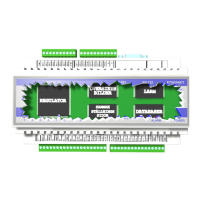6
43
6 - Controllers
If you have assigned names to all inputs and outputs, they
will appear by name in the lists. There is a New option in
the list of control outputs. You should choose this option if
you are using a "three-state actuator". The outputs are ac-
tually congured later in a special dialog. See 6.4 and 11.1.
Select control and operation signals for both pumps. Twin
pump automation will only work if each pump provides a
feedback signal. A feedback signal is an input signal with
the same state as the output signal. For example, if the
motor circuit breaker is tripped, the input signal changes
to 0 while the output signal remains 1. This causes the
second pump to start and triggers an alarm.
Select transducer 1.
Choose how you want to generate the actual value for the
controller. If two sensors are connected, you can use the
highest or lowest temperature at either of the sensors, or
the mean value. One of the sensors can also be used for
the minimum limit. In this example there is only one sen-
sor.
Pump operation
A heating controller has the fol-
lowing pump options:
No pump.
Single pump.
Single pump with spare pump.
Twin pump.
All pumps can be used with
feedback alarms. In other words, a
digital input to indicate operation
must have the same status as the
output controlling the pump.
Transducer
A controller can have two trans-
ducers, which can work in four
dierent ways:
Mean value control.
Control by sensor with the lowest
temperature.
Control by sensor with the highest
temperature.
Sensor 2 can be used for the mini-
mum threshold.
Control curves
The curves have up to ten break-
points, which you can drag in
either the X direction or the Y
direction. The value of the active
point appears below the chart. You
can use the curve tool if you want
to reduce the number of break-
points, import values in table form
or change the scaling of the axes.
See section 8.

